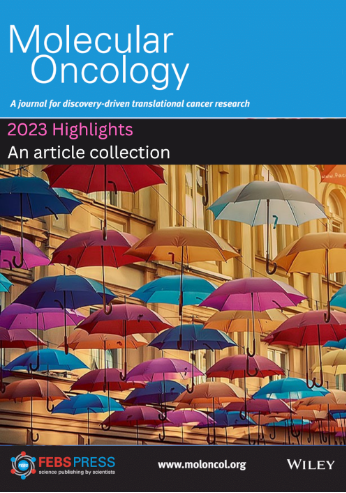Fractionated irradiation of MCF7 breast cancer cells rewires a gene regulatory circuit towards a treatment‐resistant stemness phenotype
IF 5
2区 医学
Q1 ONCOLOGY
引用次数: 2
Abstract
Radiotherapy is the standard of care for breast cancer. However, surviving radioresistant cells can repopulate following treatment and provoke relapse. Better understanding of the molecular mechanisms of radiation resistance may help to improve treatment of radioresistant tumours. To emulate radiation therapy at the cellular level, we exposed MCF7 breast cancer cells to daily radiation doses of 2 Gy up to an accumulated dose of 20 Gy. Fractionally irradiated cells (FIR20) displayed increased clonogenic survival and population doubling time as compared with age‐matched sham‐irradiated cells and untreated parental MCF7 cells. RNA‐sequencing revealed a core signature of 229 mRNAs and 7 circular RNAs of which the expression was significantly altered in FIR20 cells. Dysregulation of several top genes was mirrored at the protein level. The FIR20 cell transcriptome overlapped significantly with canonical radiation response signatures and demonstrated a remarkable commonality with radiation and endocrine therapy resistance expression profiles, suggesting crosstalk between both acquired resistance pathways, as indicated by reduced sensitivity to tamoxifen cytotoxicity of FIR20 cells. Using predictive analyses and functional enrichment, we identified a gene‐regulatory network that promotes stemness and inflammatory signalling in FIR20 cells. We propose that these phenotypic traits render breast cancer cells more radioresistant but may at the same time serve as potential targets for combination therapies.MCF7乳腺癌症细胞的部分照射重新连接基因调节回路,使其具有治疗抗性的干性表型
放射治疗是癌症治疗的标准。然而,存活下来的抗辐射细胞可以在治疗后重新繁殖,并引发复发。更好地了解抗辐射的分子机制可能有助于改善抗辐射肿瘤的治疗。为了在细胞水平上模拟放射治疗,我们将MCF7乳腺癌症细胞暴露于每日2 Gy,累计剂量为20 Gy.与年龄匹配的假照射细胞和未经处理的亲本MCF7细胞相比,部分照射细胞(FIR20)显示出增加的克隆生存率和群体倍增时间。RNA测序揭示了229个mRNA和7个环状RNA的核心特征,其中表达在FIR20细胞中发生了显著改变。几个顶级基因的失调反映在蛋白质水平上。FIR20细胞转录组与典型的辐射反应特征显著重叠,并与辐射和内分泌治疗耐药性表达谱表现出显著的共性,表明两种获得性耐药性途径之间存在串扰,如FIR20细胞对三苯氧胺细胞毒性的敏感性降低所示。通过预测分析和功能富集,我们确定了一个促进FIR20细胞干性和炎症信号传导的基因调控网络。我们提出,这些表型特征使癌症乳腺细胞更具抗辐射性,但同时可能成为联合治疗的潜在靶点。
本文章由计算机程序翻译,如有差异,请以英文原文为准。
求助全文
约1分钟内获得全文
求助全文
来源期刊

Molecular Oncology
医学-肿瘤学
CiteScore
12.60
自引率
1.50%
发文量
203
审稿时长
6-12 weeks
期刊介绍:
Molecular Oncology highlights new discoveries, approaches, and technical developments, in basic, clinical and discovery-driven translational cancer research. It publishes research articles, reviews (by invitation only), and timely science policy articles.
The journal is now fully Open Access with all articles published over the past 10 years freely available.
 求助内容:
求助内容: 应助结果提醒方式:
应助结果提醒方式:


